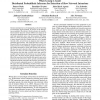156 search results - page 25 / 32 » Insider Threat Analysis Using Information-Centric Modeling |
AAAI
2006
13 years 9 months ago
2006
Intrusion attempts due to self-propagating code are becoming an increasingly urgent problem, in part due to the homogeneous makeup of the internet. Recent advances in anomalybased...
ACSAC
2002
IEEE
14 years 14 days ago
2002
IEEE
The threat to organisations from network attacks is very real. Current countermeasures to denial of service (DoS) attacks rely on the perimeter model of network security. However,...
PERCOM
2011
ACM
13 years 2 months ago
2011
ACM
We describe AnonySense, a privacy-aware system for realizing pervasive applications based on collaborative, opportunistic sensing by personal mobile devices. AnonySense allows app...
ESORICS
2007
Springer
14 years 1 months ago
2007
Springer
Port knocking is a technique first introduced in the blackhat and trade literature to prevent attackers from discovering and exploiting potentially vulnerable services on a networ...
25
Voted
INFOCOM
2003
IEEE
14 years 23 days ago
2003
IEEE
— It has been clear since 1988 that self-propagating code can quickly spread across a network by exploiting homogeneous security vulnerabilities. However, the last few years have...

